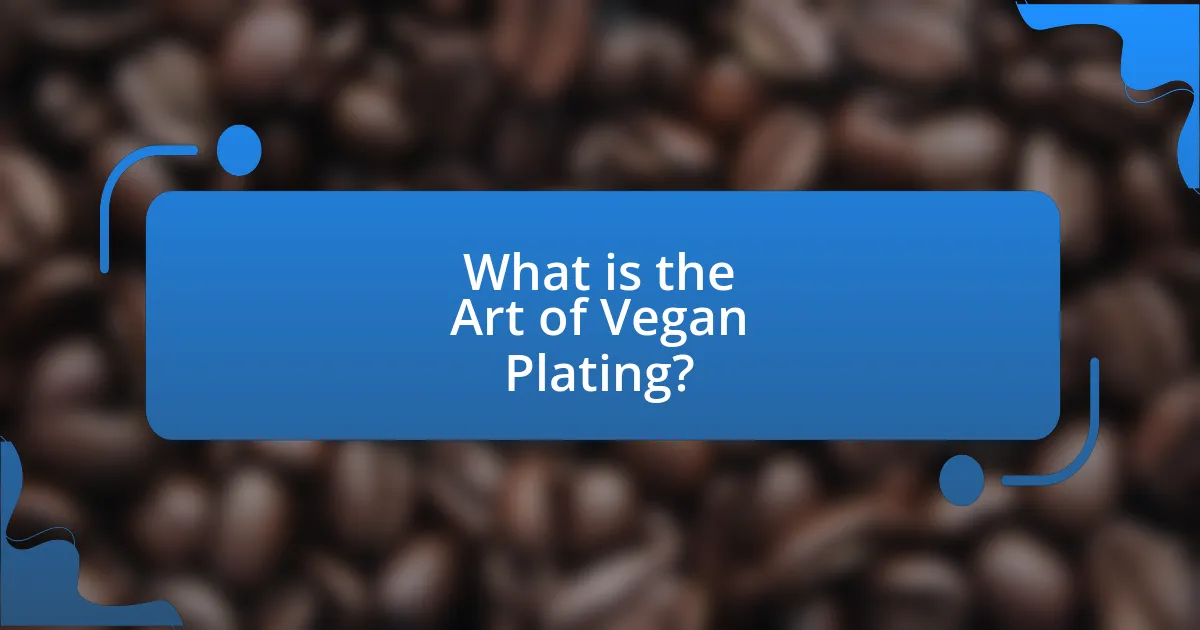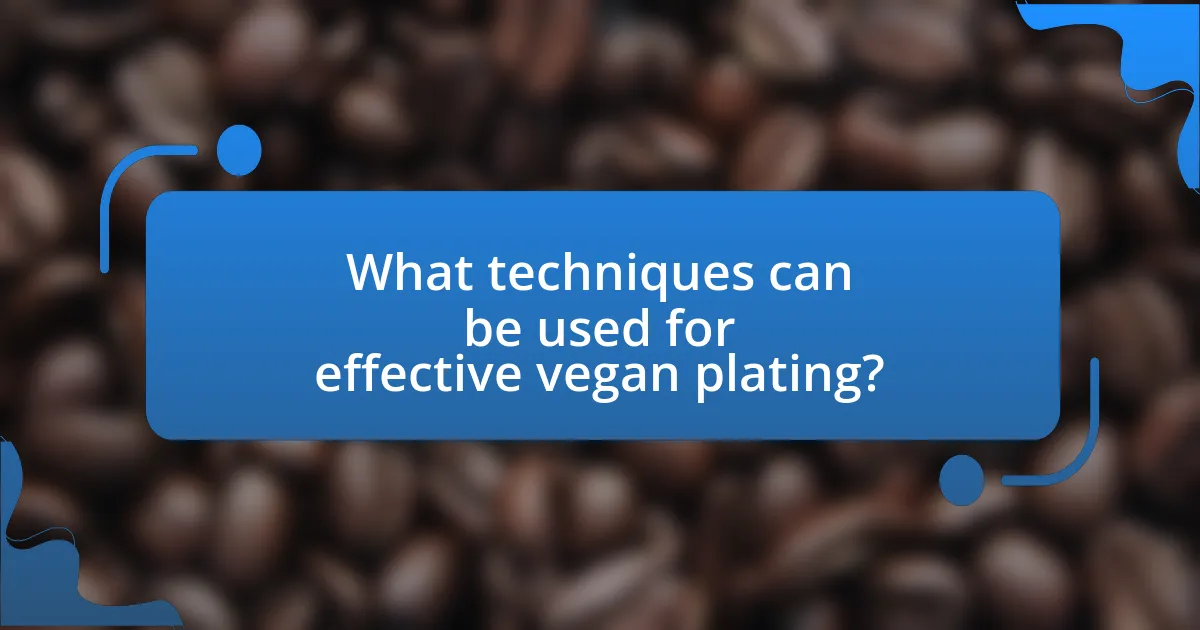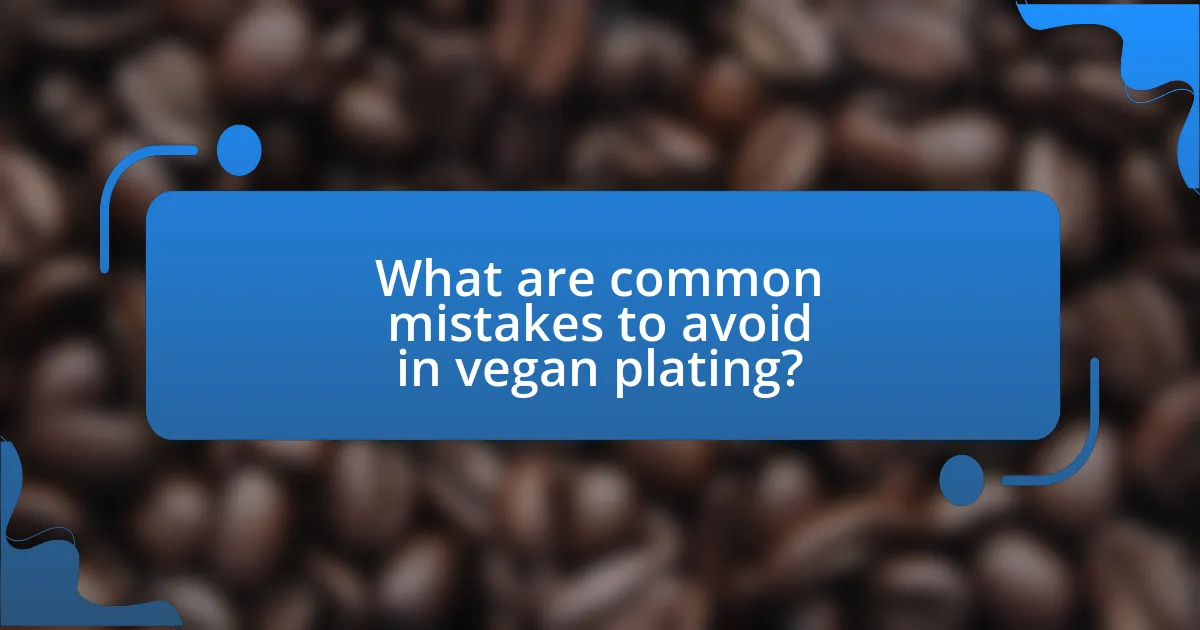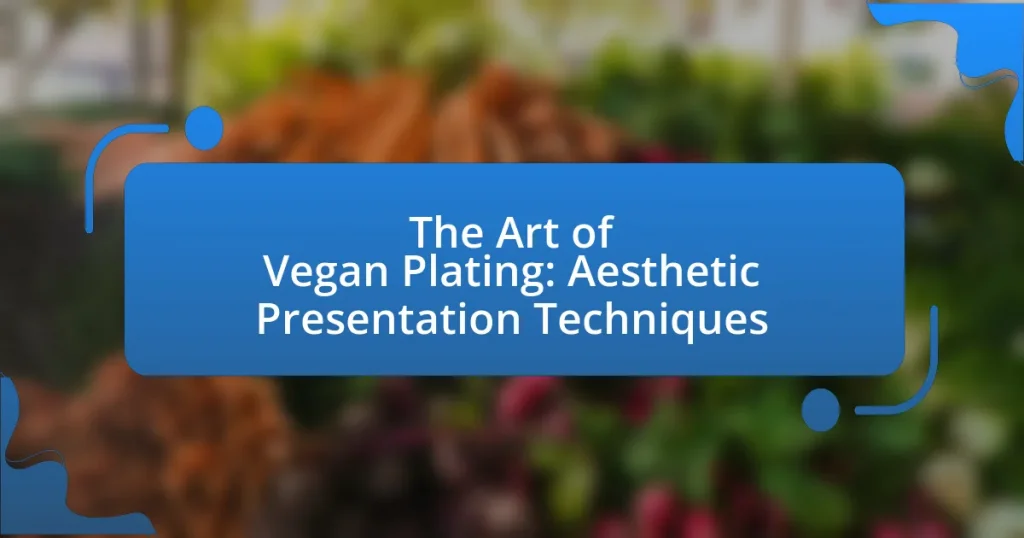The Art of Vegan Plating focuses on the aesthetic presentation of plant-based dishes to enhance their visual appeal and overall dining experience. Key elements include the use of color contrast, texture variety, and strategic arrangement, which can significantly influence diners’ perceptions of taste and enjoyment. Effective plating techniques, such as layering and garnishing, are essential for creating visually enticing meals that highlight the vibrant qualities of vegan ingredients. The article also addresses common mistakes in plating and offers practical tips to improve presentation skills, emphasizing the importance of simplicity and balance in vegan cuisine.

What is the Art of Vegan Plating?
The Art of Vegan Plating involves the creative and aesthetic presentation of plant-based dishes to enhance visual appeal and dining experience. This technique emphasizes the use of color, texture, and arrangement to make vegan meals visually enticing, often incorporating elements like vibrant vegetables, artistic garnishes, and thoughtful layering. Research indicates that visually appealing food can enhance perceived taste and enjoyment, making plating an essential skill in vegan cuisine.
How does aesthetic presentation enhance vegan dishes?
Aesthetic presentation enhances vegan dishes by making them visually appealing, which can increase appetite and enjoyment. Research indicates that people are more likely to perceive food as tastier when it is attractively arranged; for instance, a study published in the journal “Appetite” found that visually appealing food can enhance perceived flavor and overall satisfaction. This is particularly important for vegan dishes, which may sometimes be perceived as less flavorful or appealing compared to non-vegan options. By utilizing vibrant colors, varied textures, and artistic arrangements, chefs can elevate the dining experience, encouraging more people to appreciate and choose plant-based meals.
What are the key elements of visual appeal in vegan plating?
The key elements of visual appeal in vegan plating include color contrast, texture variety, arrangement, and garnishing. Color contrast enhances the dish’s vibrancy, making it more inviting; for example, pairing bright greens with deep reds creates a striking visual effect. Texture variety adds interest, as combining creamy elements with crunchy components engages the senses. Arrangement involves strategic placement of food on the plate to create balance and focal points, often following the rule of thirds for aesthetic appeal. Finally, garnishing with fresh herbs or edible flowers not only adds color but also elevates the overall presentation, making the dish more enticing. These elements collectively contribute to a visually appealing vegan plate that attracts attention and enhances the dining experience.
How do colors and textures play a role in vegan presentation?
Colors and textures significantly enhance vegan presentation by creating visual appeal and stimulating appetite. The use of vibrant colors, such as greens, reds, and yellows, can evoke freshness and health, making dishes more enticing. For instance, a salad featuring a mix of leafy greens, cherry tomatoes, and bell peppers not only looks appealing but also indicates a variety of nutrients. Textures, such as the crunch of raw vegetables contrasted with the creaminess of avocado or hummus, add depth to the dining experience. Research indicates that visually appealing dishes can increase perceived taste and enjoyment, as seen in studies published in the journal “Appetite,” which demonstrate that colorful and textured presentations can enhance the overall perception of flavor.
Why is plating important in vegan cuisine?
Plating is important in vegan cuisine because it enhances the visual appeal of dishes, making them more enticing and enjoyable. The aesthetic presentation of food can significantly influence a diner’s perception and experience, as studies show that visually appealing meals can enhance taste perception and increase satisfaction. For instance, research published in the journal “Appetite” indicates that the way food is presented can affect the perceived flavor and overall enjoyment of the meal. Therefore, effective plating techniques in vegan cuisine not only showcase the vibrant colors and textures of plant-based ingredients but also elevate the dining experience, encouraging more people to appreciate and choose vegan options.
How does plating influence the dining experience?
Plating significantly influences the dining experience by enhancing visual appeal and setting the tone for the meal. A well-executed presentation can stimulate appetite and create anticipation, as studies show that people often judge food quality based on its appearance. For instance, research published in the journal “Appetite” indicates that visually appealing dishes can increase perceived taste and enjoyment, leading to a more satisfying dining experience. Thus, effective plating not only elevates the aesthetic value of vegan dishes but also enhances overall enjoyment and engagement during the meal.
What psychological effects does presentation have on diners?
Presentation significantly influences diners’ psychological experiences by enhancing their perception of taste and enjoyment. Research indicates that visually appealing food can lead to increased anticipation and satisfaction, as the brain associates attractive presentation with higher quality and flavor. A study published in the journal “Appetite” by Spence et al. (2016) found that participants rated the taste of food more favorably when it was presented in an aesthetically pleasing manner, demonstrating that visual appeal can alter taste perception. This effect is rooted in the concept of sensory interaction, where visual stimuli can enhance or modify the experience of other senses, such as taste and smell.

What techniques can be used for effective vegan plating?
Effective vegan plating techniques include using contrasting colors, varying textures, and strategic placement of components. Contrasting colors enhance visual appeal; for instance, pairing vibrant greens with deep reds or yellows creates an eye-catching dish. Varying textures, such as combining creamy sauces with crunchy toppings, adds depth and interest. Strategic placement involves arranging food in a way that guides the viewer’s eye, often using the rule of thirds for balance. These techniques are supported by culinary principles that emphasize aesthetics in food presentation, which can significantly enhance the dining experience.
How can one create height and dimension in vegan dishes?
To create height and dimension in vegan dishes, one can layer ingredients vertically and utilize various textures. Layering can be achieved by stacking components like roasted vegetables, grains, and sauces, which not only adds visual appeal but also enhances flavor combinations. For instance, using a ring mold to stack quinoa, sautéed greens, and grilled tofu creates a structured presentation. Additionally, incorporating elements such as microgreens, edible flowers, or sauces drizzled artistically can further elevate the dish’s appearance. This technique is supported by culinary practices that emphasize visual aesthetics, demonstrating that height and dimension contribute to an engaging dining experience.
What tools are essential for achieving height in plating?
Essential tools for achieving height in plating include ring molds, plating spoons, and tweezers. Ring molds allow chefs to stack ingredients neatly, creating layers that enhance visual appeal. Plating spoons help in drizzling sauces or purees, adding dimension to the presentation. Tweezers are useful for placing delicate garnishes precisely, ensuring that each element is positioned thoughtfully. These tools collectively contribute to a structured and elevated presentation, which is crucial in vegan plating to highlight the dish’s aesthetic qualities.
How does layering contribute to the overall presentation?
Layering enhances the overall presentation by creating depth and visual interest in a dish. This technique allows for the separation of flavors and textures, making the meal more appealing and engaging to the viewer. For example, a well-layered vegan dish can showcase vibrant colors and varied ingredients, which not only attract attention but also stimulate appetite. Studies in culinary arts indicate that visually appealing presentations can increase perceived taste and enjoyment, reinforcing the importance of layering in effective plating.
What role does garnishing play in vegan plating?
Garnishing plays a crucial role in vegan plating by enhancing visual appeal and adding texture and flavor to the dish. In vegan cuisine, where colors and textures can be limited, garnishes such as fresh herbs, edible flowers, or colorful sauces can elevate the presentation, making the dish more enticing. Research indicates that visually appealing food can increase perceived taste and enjoyment, as demonstrated in studies showing that presentation significantly influences diners’ expectations and satisfaction. Therefore, effective garnishing not only beautifies vegan dishes but also contributes to a more enjoyable dining experience.
Which garnishes are most effective for vegan dishes?
Effective garnishes for vegan dishes include fresh herbs, edible flowers, nuts, seeds, and colorful vegetables. Fresh herbs like cilantro, basil, and parsley enhance flavor and add visual appeal, while edible flowers such as nasturtiums and pansies provide vibrant colors and unique textures. Nuts and seeds, like toasted pine nuts or sesame seeds, contribute crunch and nutritional value. Additionally, colorful vegetables, such as radishes or microgreens, can elevate the dish’s presentation. These garnishes not only improve aesthetics but also complement the flavors of vegan dishes, making them more appealing and enjoyable.
How can garnishes enhance flavor and visual appeal?
Garnishes enhance flavor and visual appeal by adding contrasting tastes and vibrant colors to a dish. For instance, fresh herbs like cilantro or basil can introduce a burst of freshness that complements the main ingredients, while colorful vegetables or edible flowers can create an eye-catching presentation. Research indicates that visual appeal significantly influences taste perception; a study published in the journal “Appetite” found that people rated the flavor of food higher when it was presented attractively. Thus, garnishes serve both functional and aesthetic purposes, elevating the overall dining experience.

What are common mistakes to avoid in vegan plating?
Common mistakes to avoid in vegan plating include neglecting color contrast, overcrowding the plate, and failing to consider texture variety. Neglecting color contrast can lead to a visually unappealing dish; studies show that colorful plates enhance appetite and enjoyment. Overcrowding the plate can overwhelm the viewer and detract from the individual components, making it difficult to appreciate each element. Additionally, failing to consider texture variety can result in a monotonous eating experience; incorporating different textures can elevate the dish’s appeal and complexity.
How can overcomplication ruin a vegan plate?
Overcomplication can ruin a vegan plate by overwhelming the dish with excessive ingredients and flavors, which can detract from the natural tastes of the plant-based components. When a vegan plate contains too many elements, it can lead to confusion in flavor profiles, making it difficult for diners to appreciate the individual ingredients. Research indicates that simplicity in plating enhances the overall dining experience, as it allows the primary ingredients to shine and be the focal point of the meal. For instance, a study published in the Journal of Culinary Science & Technology highlights that minimalist presentations often lead to higher satisfaction among diners, as they can better identify and enjoy the distinct flavors of each component.
What are the signs of cluttered plating?
Signs of cluttered plating include excessive food items on the plate, overlapping ingredients, and a lack of negative space. When a plate is overloaded with components, it can create visual chaos, making it difficult for the diner to appreciate individual flavors and textures. Additionally, if sauces or garnishes are haphazardly applied, it further contributes to a disorganized appearance. Research in culinary presentation emphasizes that a well-composed plate should balance elements to enhance the dining experience, highlighting the importance of simplicity and clarity in plating.
How can simplicity enhance the presentation of vegan dishes?
Simplicity enhances the presentation of vegan dishes by allowing the natural colors and textures of the ingredients to stand out. When a dish is presented with minimal distractions, the vibrant hues of vegetables and the intricate details of plant-based components become more visually appealing. Research indicates that visually appealing food can increase appetite and enjoyment; for instance, a study published in the journal “Appetite” found that simpler presentations can lead to higher perceived quality and satisfaction among diners. Therefore, by focusing on simplicity, chefs can create a more impactful visual experience that highlights the beauty of vegan ingredients.
What are the best practices for plating vegan meals?
The best practices for plating vegan meals include using a variety of colors, textures, and shapes to create visual interest. Incorporating vibrant vegetables, grains, and legumes enhances the aesthetic appeal, as studies show that colorful plates are more appetizing and engaging. Additionally, utilizing negative space on the plate allows the food to stand out, making the presentation more sophisticated. Arranging components in a way that highlights their unique textures, such as stacking or layering, can also elevate the dish’s visual impact. Finally, garnishing with fresh herbs or edible flowers not only adds color but also enhances flavor, making the meal more inviting.
How can one ensure balance and harmony in a vegan plate?
To ensure balance and harmony in a vegan plate, one should incorporate a variety of colors, textures, and flavors while ensuring nutritional completeness. A balanced vegan plate typically includes a source of protein, such as legumes or tofu, a variety of vegetables for vitamins and minerals, whole grains for carbohydrates, and healthy fats from sources like avocados or nuts. Research indicates that a colorful plate not only enhances visual appeal but also signifies a range of nutrients; for example, the Harvard T.H. Chan School of Public Health emphasizes the importance of including diverse plant-based foods to meet dietary needs. By thoughtfully combining these elements, one can create a visually appealing and nutritionally balanced vegan meal.
What tips can help maintain cleanliness and precision in plating?
To maintain cleanliness and precision in plating, use a clean workspace and tools, ensuring that all utensils and plates are sanitized before use. This practice minimizes contamination and promotes a professional appearance. Additionally, employ techniques such as using a squeeze bottle for sauces, which allows for controlled application and reduces mess. Keeping a damp cloth nearby helps quickly wipe any spills or smudges on the plate’s edge, enhancing the overall presentation. Finally, practice portion control to ensure uniformity in serving sizes, which contributes to a polished and precise look on the plate.
What practical tips can enhance your vegan plating skills?
To enhance your vegan plating skills, focus on color contrast, texture variety, and strategic arrangement. Utilizing a vibrant color palette can make dishes visually appealing; for instance, pairing bright greens with deep reds or purples creates an eye-catching contrast. Incorporating different textures, such as creamy sauces alongside crunchy toppings, adds depth to the presentation. Arranging food in a way that guides the viewer’s eye, such as using the rule of thirds or creating height with stacked ingredients, can elevate the overall aesthetic. These techniques are supported by culinary studies that emphasize the importance of visual appeal in food enjoyment, demonstrating that well-plated dishes can enhance the dining experience.


